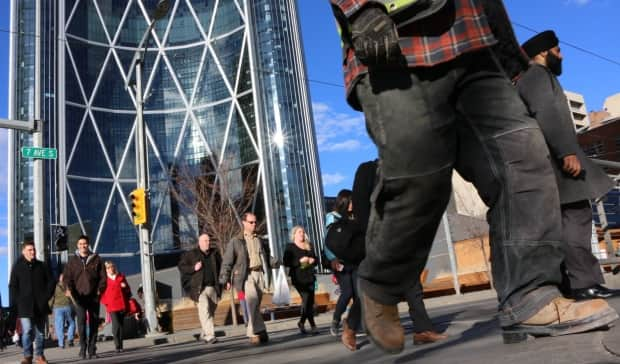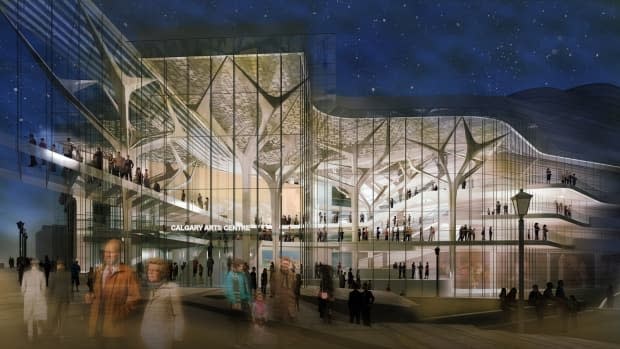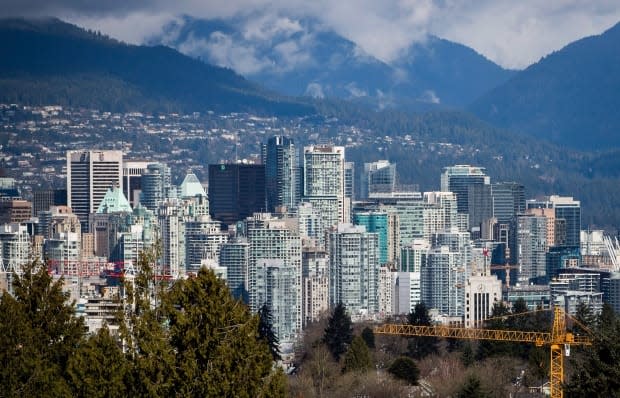The dollars and sense behind Calgary's plan to save downtown


When city council sat down to hear about the new plan for revitalizing downtown Calgary, there was a lot of aspirational talk about bustle and tech jobs and bike lanes and nightlife. "Vacancy to vibrancy" was repeated enough that it would have put any participant in a catchphrase drinking game under the table.
It would have been easy to walk away feeling inspired about the bright future for a hip and artsy Calgary core. But what is the actual business plan behind the grand vision? Who's paying how much for what, and why?
In total, the city wants to spend $1 billion over the next 10 years on everything from incentivizing office tower conversions to building more bike and pedestrian infrastructure, investing in arts and green spaces and more. It hopes to have help from the province and Ottawa for some of the costs.
The argument is that the city can't thrive without a downtown core that helps foot the bill.
In a sense, the downtown strategy the city hopes will breathe new life into a hollowed out core is a long-overdue reckoning with Calgary's dependence on oil wealth and the towers it spawned. That wealth is unlikely to return, but without a downtown recovery of some kind, the city will struggle.
A massive fiscal hole
When oil was riding high, money flooded into the core, building a downtown that was more suited to a city four times Calgary's size.
Investment dollars and the soaring revenues of the oil and gas companies helped feed the frenzy with restaurants and bars doing a brisk weekday business. Pension funds, insurance companies and real estate trusts gobbled up properties to shore up their investments.
Much like the provincial treasury, the city grew fat on the oil wealth in its core and became too reliant on what amounted to a single source of taxes. When the oil crash started hollowing out those towers, it took soaring tax assessments with it.
The core lost approximately $16 billion in value. The vacancy rate currently sits at around 30 per cent.

The city found itself with a hole in its tax base in the hundreds of millions of dollars and has spent $259 million over the past four years plugging that hole through what it calls a phased tax program aimed at softening the blow for other businesses outside the core that now have to cover more of the tax burden.
That solution has only served as an expensive Band-Aid for the wider issue. The city wants a more permanent solution.
The strategy
The downtown strategy calls for $1 billion in spending over the next 10 years, with details yet to come. But city council has approved the first $200 million, including:
$45 million for incentives for existing office space to convert to residential, redevelop or look at "adaptive use."
$5 million to offset contributions to the Plus-15 fund for residential developments.
$55 million for a "downtown vibrancy capital program."
$5 million for programming events.
$10 million for a "dedicated downtown team" to oversee implementation.
$80 million for the previously announced Arts Commons transformation.
"Before we had that whole tax shift issue a few years ago, I don't think a lot of people realised how heavily reliant we were on downtown property values," said Thom Mahler, the manager of urban initiatives at the city of Calgary and the point person for the downtown strategy.
He said the city needs to revitalize and diversify its core, but does not expect the wealth of the past to return to the downtown.
"It wouldn't be healthy if we went back to the same situation, where we were again super reliant on our downtown," said Mahler.
Hannes Kovac, the chair of OPUS Corporation and co-chair of Calgary Economic Development's Real Estate Sector Advisory Committee (RESAC), which advised the city, says he thinks the $450 million the city wants to invest in converting downtown office towers to other uses alone will attract "well beyond a billion dollars in investment" and bring tax revenue.

"So if you invest $450 million over 10 years, the city will get back over that exact same period of time, $580 million in property tax revenue," he said, adding that doesn't account for $146 million created for the province.
Kovac also points to construction jobs and new businesses opening in the core.
The city, as part of the plan, hopes to tap into hundreds of millions of dollars in federal funding for housing and green retrofits, as well as provincial dollars.
None of that return, nor any of the government funding is guaranteed.
But it's not just dollars and cents. There's also a sense of being passed by — of investors casting their gaze elsewhere, said Mahler.
The strategy then is also meant to signal to Calgarians and investors that the downtown is important and the city will work to bring it back.
That involves getting everyone on board with the strategy.
The challenges
Calgary is unique. It has a massive concentration of office towers in its core with little diversity and comparatively little housing. That lack of diversity has resulted not only in the precipitous fall, but in a challenging path forward as well.
Pierre Filion, professor emeritus in University of Waterloo's school of planning, says the cities with downtowns that are doing well in North America are the ones that have historically done well. Think New York and Chicago versus Los Angeles or Phoenix.
The cities with a core at their core have an advantage and he says Calgary has something to build upon, but the foundation is weak.
"One problem with downtown Calgary is that it wasn't built on what was previously a dense inner-city area, or a previous generation downtown," said Fillion.
On most sides of the downtown you have a sort of jarring transition from semi-suburban areas with single-family homes to downtown.

Mahler says his team is about to start work on a downtown housing strategy — a key piece of the business puzzle that will help determine how much of a market there is and what the future of downtown employment and incomes could look like.
Jenna Dutton, the research coordinator of the urban policy program at the Calgary School of Public Policy, says the downtown strategy shows promise, but has to remain focused on all aspects, not just tackling the vacancy issue in a silo.
She says the plan is innovative, or at least as innovative as it can be, given all the competing interests at play.
"I would just say, it is innovative, but it perhaps could have been a little bit more bold," said Dutton.
"I think sometimes that's the nature of public engagement and bringing in the private sector stakeholders, because there's always hesitancy, especially with local government, in terms of being risk averse."
But just who is taking on the financial risk of the plan?
The public and the private
Calgary's core is not just a collection of buildings. It's a giant vault for wealth. The majority of the properties downtown are places where large institutions park money in order to manage investments.
So where does the public and the private interest overlap?
Better amenities downtown, alongside more bars, restaurants and retail shops would help breathe more life into the core for the benefit of all. Increased tax revenues would help the broader city, and the downtown building owners would theoretically enjoy higher rents from the more desirable location.
That's the goal.
Martine August is a professor of planning at the University of Waterloo who studies the impacts of financialization on multi-family housing — essentially, the consequences of viewing real estate as an investment product rather than, say, a place to live or work, or as part of a neighbourhood.
"There are equity related impacts of looking at buildings and property and community through the lens of trying to maximise profits for investors, it just leads to the type of decision-making that can conflict with other types of goals," she said.
Even decisions that could benefit the broader city can have the impact of gentrification and displacement, with stakeholders pushing for initiatives that raise prices rather than focusing on a greater social good.
Financialization also puts distance between owners and local decision makers and can muddy the understanding of who stands to benefit from local decisions and why.
August, who has not examined the Calgary plan, questions the use of public dollars to help shift the business fortunes of owners.
Click on the icons in the map below to see who owns or is thought to own various downtown properties and which ones might be repurposed first. If you can help help determine the ownership of a building or notice anything that's wrong, we'd love to hear from you: please email drew.anderson@cbc.ca with the building address and ownership.
"So they banked on a certain type of commercial real estate, asset class office, and then that's not doing so well and they're going to get bailed out by taxpayers, essentially. To be made whole, to come up with a more profitable type of use for that real estate," she said.
"And I think that there are important questions that we should be asking about if that's a good use of social spending."
Mahler, the city's manager of urban initiatives, says in order for the plan to work, the city needs both the public and the private on board, but there are challenges.
"The thing we don't always know as a city, is the financial strategy behind those buildings, because often they're just building a much larger portfolio of national and international companies," he said.
He says the city will focus on ensuring there is a mix of housing and other options, in an effort to not price people out of the core.
Now the city just has to work on changing the perspective of the financial and investment community in regards to the future of downtown Calgary, said Mahler.
The socialization of risk
The city is no doubt putting itself on the line in order to try and reinvent a downtown that has been singularly focused for too long. It hopes the money it pools into the strategy will help shake free private funds and other government funding.
It is essentially trying to kickstart a revival that will spiral into more investments, more amenities, more people and more taxes that can then be used to make ever greater improvements.
Mahler argues the greater risk is not doing anything and says the longer you do nothing as a downtown decays, the harder it is to ever build it back.
The city has already invested hundreds of millions of dollars on temporary fixes for the impact of a hollowing out downtown with no tangible move toward a solution.
A lot will rest on the details of the incentives, funding and spending that will be outlined by the city in the coming months. In the meantime, the city will push forward with trying to make the downtown more attractive with more events as the sales pitch continues.
"I think the longer the city kind of waits for the private sector alone to do something, then the longer it goes where the downtown, kind of has no character or vibrancy, and is not appealing," said Dutton with the School of Public Policy.
"So I think like the broader system ramifications there are quite high."

 Yahoo Finance
Yahoo Finance 